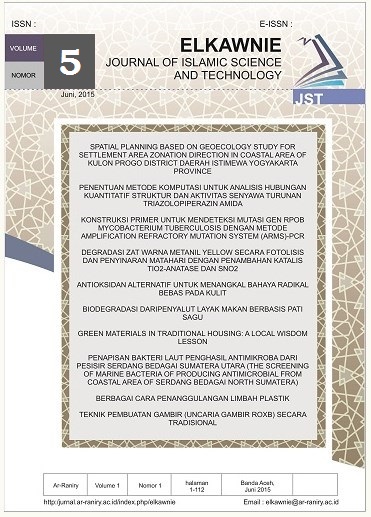Evaluation of Antioxidant Activity On Plum Fruit (Prunus domestica L.) Skin Extract Applied For Natural Acid-Base Indicator
DOI:
https://doi.org/10.22373/ekw.v5i1.4516Keywords:
acid-base, antioxidant, anthocyanin, indicator, plumAbstract
Plum peel was extracted through the maceration method with 100 mL ethanol. This process obtained 5% (50 µg/µL) skin extract. The UV-Vis spectrum of the extract displayed the major absorption peak at λmax = 526 nm in acid media, this assigned by the electronic transition from flavylium which as characteristic of anthocyanin compounds. The of anthocyanins stability on temperature effect showed the absorbance decreases with the heating time, while the level of pigment color loss, or the percentage of color loss, gradually increases. The pigment was maintained at 100oC for 100 min with the loss rate reaches 58.5%. Therefore, The loss of anthocyanin color in the plum peel is relatively stable at lower temperatures. Then, The plum peels extract shown the red color at pH 1-3, almost colorless at pH 4-7, and violet color at pH 12. Finally, plum peels extract was potentially used as the acid-base indicator.References
Aal, E. S. S. M. A., Hucl, P., & Rabalski,I. (2018). Compositional and antioxidant properties of anthocyanin-rich products prepared from purple wheat. Food Chem, 254, 13-19. DOI: https://doi.org/10.1016/j.foodchem.2018.01.170
Abdel-Aty, A. M., Salama, W. H., Fahmy, A. S., & Mohamed, S. A. (2018). Impact of germination on antioxidant capacity of garden cress: New calculation for determination of total antioxidant activity” Scientia Horticulturae, 246(27), 155-160. DOI: https://doi.org/10.1016/j.scienta.2018.10.062
Baldigo, B. P., Kulp, M. A., & Schwartz, J. S. (2018). Relationships between indicators of acid-base chemistry and fish assemblages in streams of the Great Smoky Mountains National Park. Ecol. Indic., 88, 465-484. DOI: https://doi.org/10.1016/j.ecolind.2018.01.021
Chen, G. L. Fan, M. X., Wu, J. L., Li, N., & Guo, M. Q. (2018). Antioxidant and anti-inflammatory properties of flavonoids from lotus plumule. Food Chemistry, 277(30), 706-712. DOI: https://doi.org/10.1016/j.foodchem.2018.11.040
Hsiao, Y. H. , & Hsieh, J. F. (2018). The conversion and deglycosylation of isoflavones and anthocyanins in black soymilk process. Food Chem, 261, 8-14. DOI: https://doi.org/10.1016/j.foodchem.2018.03.15
Kamneva, N. N., Tkachenko, V. V., Petrossyan, N. O. M., Marynin, A. I., Ukrainets, A. I., Malysheva, M. L., & Osawa, E. (2018). Interfacial Electrical Properties of Nanodiamond Colloidal Species in Aqueous Medium as Examined by Acid-Base Indicator Dye. Surf. Eng. Appl. Electrochem., 54(1), 64-72. DOI: https://doi.org/10.3103/S1068375518010088
Kahlert, H., Meyer, G., & Albrecht, A. (2016). Color maps of acid-base titrations with Color indicators: how to choose the appropriate indicator and how to estimate the systematic titration errors. ChemTexts., 2, 7-35. DOI: https://doi.org/10.1007/s40828-016-0026-4
Macuvele, D. L. P., Sithole, G. Z. S., Cesca K., Macuvele, S. L. P., & Matsinhe, J. V. (2016). Aqueous extracts of Mozambican plants as alternative and environmentally safe acid-base indicators. Environ. Sci. Pollut. Res., 23: 11639-11644. DOI: https://doi.org/10.1007/s11356-016-6284-2
Petrossyan, N. O. M. P., Farafonov, V. S., & Lebed, A. V. (2018). Examining surfactant micelles via acid-base indicators: Revisiting the pioneering Hartley–Roe 1940 study by molecular dynamics modeling. J. Mol. Liq., 264: 683-690. DOI: https://doi.org/10.1016/j.molliq.2018.05.076
Reshetnyak, E. A., Ostrovskaya, V. M., Goloviznina, K. V., & Kamneva, N. N. (2017). Influence of tetraalkylammonium halides on analytical properties of universal acid-base indicator paper. J. Mol. Liq., 248, 610-615. DOI: https://doi.org/10.1016/j.molliq.2017.10.019
Ryu, D., & Koh, E. (2018). Stability of anthocyanins in bokbunja (Rubus occidentalis L.) under in vitro gastrointestinal digestion. Food Chem, 267, 157-162. DOI: https://doi.org/10.1016/j.foodchem.2018.02.109
Serra-Mora, P., Moliner-Martínez, Y., Herráez-Hernández, R. J., Verdú-Andrés, & Campíns-Falcó, P. (2016). Simplifying Iron Determination with o-Phenanthroline in Food Ashes Using 2-Nitrophenol as an Acid-Base Indicator. Food. Anal. Methods., 9, 1150-1154. DOI: https://doi.org/10.1007/s12161-015-0294-4
Soltan, M. E., & S. M. Sirry. (2013).Usefulness of Some Plant Flowers as Natural Acid and Base Indicators. J. Chin. Chem. Soc., 49(1), 63-68. DOI: https://doi.org/10.1002/jccs.200200011
Sukhanov, A., Ovsyannikova, A., Gavrilenko, N., & Saranchina, N. (2016). Polymethacrylate matrix with immobilized acid-base indicators as pH sensor. Procedia. Eng., 168, 477-480, DOI: https://doi.org/10.1016/j.proeng.2016.11.134
Udugala-Ganehenege, M. Y., Dissanayake, N. M., and Adhikari, A. M. K. S. P. (2015). Application of N,N′-ethylenebis(acetylacetoneiminato) Nickel (II) and Copper (II) Schiff Base Complexes as Acid-Base Sensing Materials and Indicators in Volumetric Titrations: Qualitative, Spectroscopic and Titrimetric Analyses. J. Inorg. Organomet. Polym., 25, 964-974. DOI: https://doi.org/10.1007/s10904-015-0200-y
Uranga, J., Etxabide, A., Guerrero, P., & Caba, K. D. L. (2018). Development of active fish gelatin films with anthocyanins by compression molding. Food Hydrocoll, 84, 313-320, DOI: https://doi.org/10.1016/j.foodhyd.2018.06.018
Xiong, Y., Pei, K., Wu, Y., Xiong & Y. (2018). Colorimetric ELISA based on glucose oxidase-regulated the Color of acid-base indicator for sensitive detection of aflatoxin B1 in corn samples. Food Control., 78. 317-323. DOI: https://doi.org/10.1016/j.foodcont.2017.03.002
Zoromba, M. S. (2017). Novel and economic acid-base indicator based on (p-toluidine) oligomer: Synthesis; characterization and solvatochromism applications. Spectrochim. Acta. A., 187, 61-67. DOI: https://doi.org/10.1016/j.saa.2017.06.028
Downloads
Additional Files
Published
Issue
Section
License
Proposed Policy for Journals That Offer Open Access Authors who publish with the Elkawnie journal agree to the following terms:
a. Authors retain copyright and grant the journal right of first publication with the work simultaneously licensed under a Creative Commons Attribution License that allows others to share the work with an acknowledgement of the work's authorship and initial publication in this journal.
b. Authors are able to enter into separate, additional contractual arrangements for the non-exclusive distribution of the journal's published version of the work (e.g., post it to an institutional repository or publish it in a book), with an acknowledgement of its initial publication in this journal.
c. Authors are permitted and encouraged to post their work online (e.g., in institutional repositories or on their website) prior to and during the submission process, as it can lead to productive exchanges, as well as earlier and greater citation of published work (see The Effect of Open Access).

























